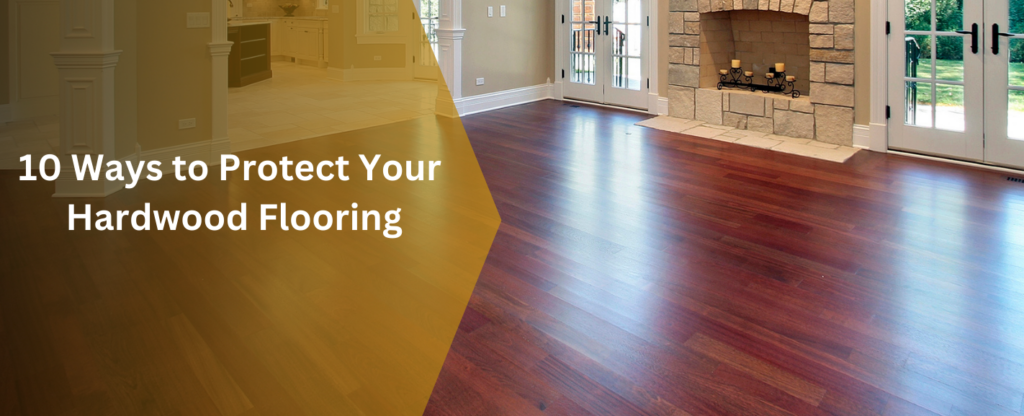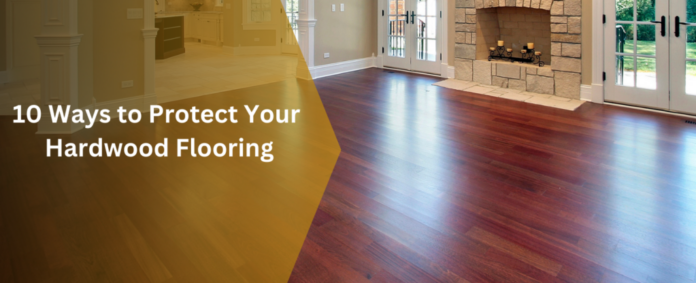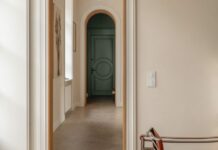
Hardwood floors add timeless elegance to any home, enhancing both its aesthetic appeal and value.
As gorgeous as wood flooring is, it requires proper care to maintain its gleam and longevity. Scratches, water damage, and everyday wear can quickly diminish the beauty of hardwood floors.
To help homeowners preserve the natural beauty of their wood floors, we’ve compiled a list of the 5 biggest threats and 10 essential tips on how to protect hardwood floors.
Ways to Protect Your Floors
Prevention is the first step in protecting your hardwood floors. It’s as simple as vacuuming or wiping it regularly. Below are some specific tips to keep your floors clean and protected for years to come.
1. Use Furniture Pads
Hardwood floors are generally pretty durable, but they can be prone to scratching over time. The two worst offenders are furniture and dog or cat claws.

If you’re wondering how to protect hardwood floors from chairs, there’s an easy answer: furniture pads. These are small felt pads you can attach to the bottoms of furniture legs, preventing scrapes and scratches whenever you pull out a chair or rearrange your furniture.
2. Control Your Pet’s Nails

The most common method is regular nail trimming. For young pets, measures can be taken to prevent fear of clippers or dremels. If nail clipping is challenging, you can consult a vet or a grooming salon. Additionally, a trainer or behaviorist can be engaged to simplify the process for both the pet and the owner.
3. Keep it Clean
Daily sweeping/vacuuming, dusting, or dry mopping keeps abrasive particles at bay. Occasionally, do a deep clean with an appropriately rated cleaning solution. Also, be sure to wipe up any water or spills quickly with a soft, absorbent cloth, and avoid steam cleaners. Use damp mops to finish the cleaning process and dry your floor naturally.
4. Use Mats and Rugs
To cut down on how often you need to clean, place mats, runners, or rugs at entryways and high-traffic areas. Exterior mats help keep dirt and grime from being tracked in, while other mats and runners can prevent dirt and dust from reaching the wood. You can also use rugs in individual rooms to provide a soft floor area to sit on or play on.
5. Avoid Harsh Cleaners and Steam Mops
Only use cleaners rated for hardwood floors and follow instructions. Give Bona Hardwood Floor Premium Spray Mop or Bona Hardwood Floor Cleaner Spray a try.
Cleaners like vinegar, ammonia, or harsher cleaning agents can damage the finish of your floors. Steam cleaners aren’t any better—they introduce excess water that seeps into your floor’s seams and ruins the wood.
6. Protect Your Floors During Construction or Renovation
If you’re renovating your house or undertaking any kind of construction work, safeguard your hardwood floors with construction paper, drop cloths, or plastic sheeting.
Secure the protective covering with painter’s tape to avoid residue on the wood. Make a safe path for any workers with tarp or cardboard to protect your entire home as they move through.
7.Control the Indoor Climate
Hardwood floors are sensitive to the environment. Drastic changes in humidity can cause wood to expand and contract, leading to warping or gapping. Use humidifiers or dehumidifiers to balance your air and maintain a stable and moderate indoor climate throughout the year.
8. Choose the Right Cleaning Tools
Go for a mop with a microfiber or soft cloth head, as these materials are gentle on the wood surface. Avoid abrasive brushes or tools that could cause scratches.
9. Polish and Refinish When Necessary
Over the years, hardwood floors lose their shine and may even get scratched. Polishing can refresh the finish and maintain the floor’s integrity. Refinish your floors by sanding them down and reapplying a topcoat every few years.
10. Consider Professional Maintenance
Every few years, consider scheduling professional maintenance for your hardwood floors. Professionals can assess the condition of your floors, address any issues, and apply protective coatings to enhance durability and longevity.
11. Adopt a No-Shoes Policy
Much of the dirt and debris that could potentially damage hardwood floors comes from the soles of our shoes. High heels, in particular, can cause scratches and scuffs. Encourage a house policy where shoes are left at the entrance. This simple step will not only protect your floors from scratches but will also keep your home cleaner.
Here are more ways to take care of hardwood floors.
Things that Can Harm Your Hardwood Floors
Below are common elements that can harm your hardwood floors.
Dirt and Grit
The dirt that accumulates on your hardwood floors is more harmful than it may appear. Contrary to the popular belief that it is just dirt, tiny particles of grit can cause scratches and scuffs, affecting the floor’s finish.
If the finish wears away due to excessive dirt and other abrasive substances, the wood flooring itself may be at risk of damage. Gritty dirt can also sneak into unexpected places, such as under rugs and tables.
Food Crumbs
While moisture tops the list of threats, its combination with leftover food crumbs can increase damage. Moisture and crumbs often create an environment conducive to mold and mildew growth.
Regular sweeping or vacuuming can help reduce the accumulation of crumbs, as well as encourage family members (or roommates) to be mindful of food spills. Additionally, food crumbs possess a gritty nature, further exacerbating potential damage.
Moisture
Excessive moisture presents the biggest risk to hardwood floors. Maintain optimal indoor humidity levels to prevent damage, yet many households struggle with excess moisture rather than a deficiency.
Even minimal water spills, significant leaks, heightened moisture levels, or the misuse of wet cleaning methods can infiltrate the wood, leading to deterioration.
Salt
In regions experiencing heavy snowfall, protecting wood floors extends beyond keeping snow outside. The salt used for deicing driveways and other areas poses a serious threat to wood floors. Awareness and proactive measures are essential to prevent salt-related damage to your valuable flooring.
Sun
Excessive exposure to the sun’s UV rays can be detrimental to wood floors, especially over an extended period of time. While drawing curtains and closing shutters might seem excessive, taking measures to limit prolonged exposure can safeguard your flooring from the gradual impact of sunlight.
Having knowledge of these elements can help you prevent damage to your hardwood floor before it’s too late and preserve the natural appeal and integrity of your hardwood flooring for years to come.
Need to Replace Your Hardwood Floor?
Safeguarding your hardwood floors involves not only routine maintenance but also keeping an eye on their well-being.
Considering a new hardwood floor? Choose 50Floor for an extensive range of flooring services, including both installation and repair. Schedule a free consultation today!
The post 10 Ways to Protect Your Hardwood Flooring appeared first on 50Floor.
50floor.com










